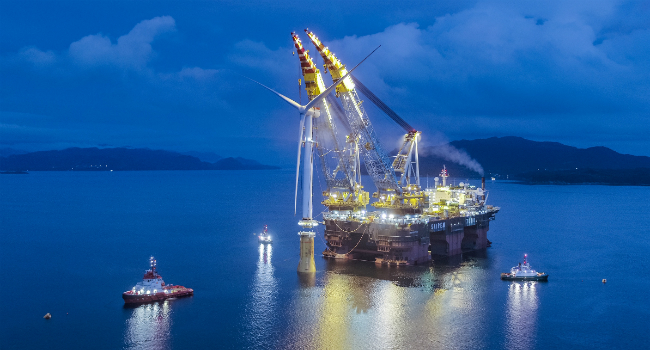- i4Offshore project to receive almost 20 million euro in support over five-year duration
- Goal is to deliver offshore wind solutions making consumers' electricity bills both lower and greener compared to fossil fuel or other renewable energy sources
- Technologies tested to include 1,000-ton bucket foundation, steel jacket, a concrete transition piece, new cable connection
- 15 project partners companies include experts from all fields within the offshore wind industry; one of the largest offshore wind energy R&D projects ever
- Official title: "Integrated Implementation of Industrial Innovations for Offshore Wind Cost Reduction"
Siemens Gamesa Renewable Energy (SGRE) and Aalborg University (AAU) in Denmark will lead the new i4Offshore research and development project focused on significantly reducing the cost of offshore wind power. Officially entitled "Integrated Implementation of Industrial Innovations for Offshore Wind Cost Reduction", the project is supported by a European Union (EU) grant of nearly 20 million euro. The project will demonstrate and test new offshore wind power technologies, leading to solutions which will make consumers' electricity bills both lower and more environmentally-friendly compared to fossil fuel sources such as oil or coal or other renewable energy sources such as solar or hydropower.
A total of 15 project partners companies are involved in the project in addition to SGRE and AAU. They are all experts within the offshore wind industry, and include Universal Foundation A/S, Bladt Industries A/S, Per Aarsleff A/S, Salzgitter AG, Windar Renovables, Dr. Techn. Olav Olsen AS, NKT Cables GmbH & Co KG, SINTEF Ocean, Bureau Veritas Marine & Offshore SA, Maersk Broker K/S, Deugro Danmark A/S, Fred. Olsen Windcarrier, Technical University of Denmark (DTU).
- Siemens Gamesa is committed to reducing the cost of offshore wind energy, and greatly welcomes this grant. Our constant focus on innovation – along with strong partners, customers, and support such as from the EU – enables us to push the industry forward, delivering a lower Levelized Cost of Energy (LCoE) and higher annual energy production. The R&D work we'll do during this project has clear goals of benefitting our customers, ratepayers, and society-at-large, says Jesper Moeller, project lead and Senior Specialist in Offshore Technologies at SGRE’s Offshore Business Unit.
An enormous engineering puzzle will be assembled
The i4Offshore project, which is based on classical engineering disciplines such as structural analysis, geotechnical engineering, production and risk analysis, will test a complete installation of a future version of a full-scale Siemens Gamesa offshore turbine. A new 1,000-ton bucket foundation, a steel jacket, a concrete transition piece and a new cable connection will prove that the technology is reliable, and that production, transport, and installation can be done more cost effectively than today.
- One of the challenges of offshore wind energy is that the high cost of building offshore wind turbines has necessitated various governmental subsidies to improve the business case. While all forms of industrial power generation receive governmental support, whether from renewable, fossil, or other sources, our project aims at making offshore wind energy even more cost-effective without external financial support, says Lars Bo Ibsen, Professor at Aalborg University.
The project aims to apply the advanced technologies to reduce the Levelized Cost of Energy (LCoE) from offshore wind. The LCoE calculations show the total cost of electricity from a particular energy technology when all costs are included. But before the project reaches that goal, the various elements must prove that they can be integrated into an overall solution.
- We already have a lot of pieces that we know work separately. Now we are in the process of assembling them into a large puzzle, and testing that they work together. As this is proven, we look to demonstrate to customers, banks, and investors that offshore wind makes even more financial and environmental sense for the future, Ibsen adds.
The culmination of over 15 years of research and development
With the grant from the EU, the partners aim to bring the technology a step further and provide an even more solid foundation for the creation of future offshore wind power plants around the world. The i4Offshore builds on a wide range of projects implemented with the support of both the EU and a number of Danish funding sources over the past 15 years.
Minimal environmental footprint
Furthermore, the project will test installation solutions with a minimal environmental footprint. The bucket foundation can be installed virtually noise-free as installation takes place via suctioning into the seabed instead of being hammered down from above.
- Using a suction-bucket foundation benefits whales and other undersea life by eliminating the soundwaves which hammering causes. Also, once the wind turbine has exhausted its many years of operational life, the suction buckets, jacket foundation, and transition piece can be decommissioned and removed relatively easily. The materials, including steel, concrete and cables, can be re-used in a highly resource-efficient manner, says Moeller.
Contacts for journalists
Siemens Gamesa:
Rasmus Windfeld
Phone: +45 4044 6060
rasmus.windfeld.ext@siemens.com
Verónica Díaz
Phone: +34 616 348 735
veronica.diaz@siemensgamesa.com
Aalborg University:
Sanne Holm Nielsen
Phone: +45 25334827
shn@adm.aau.dk

